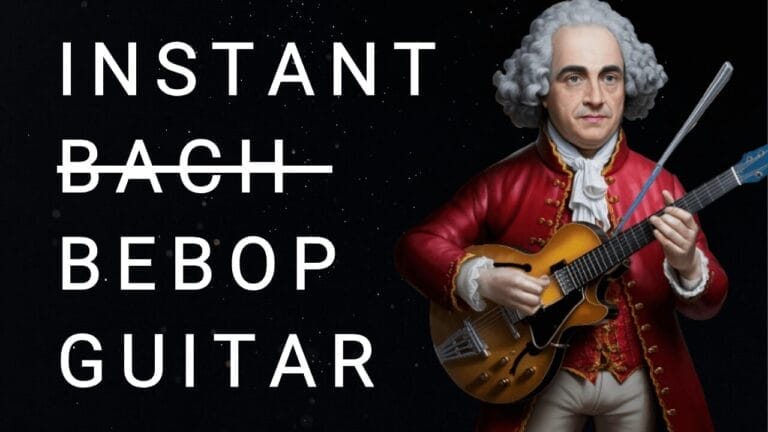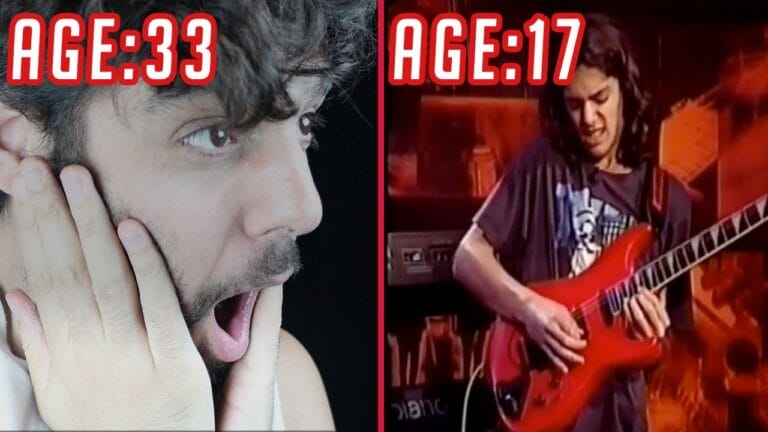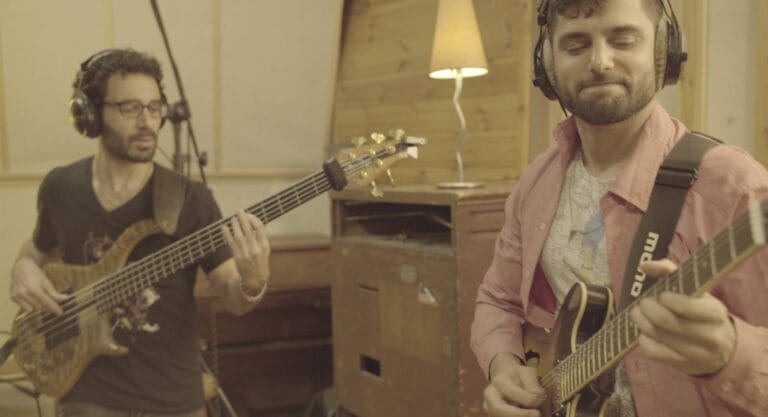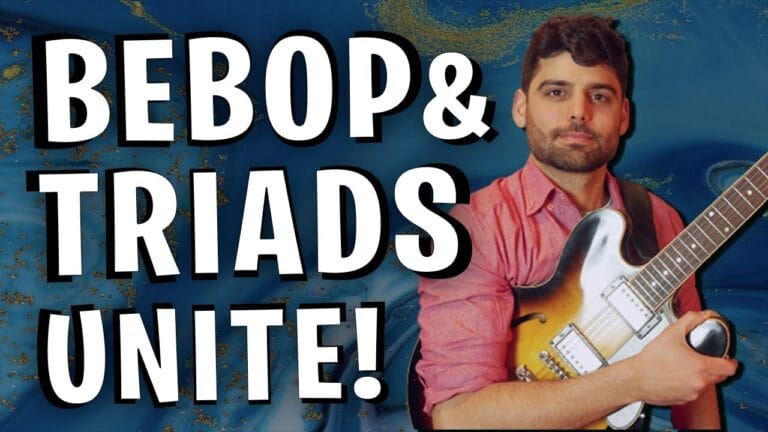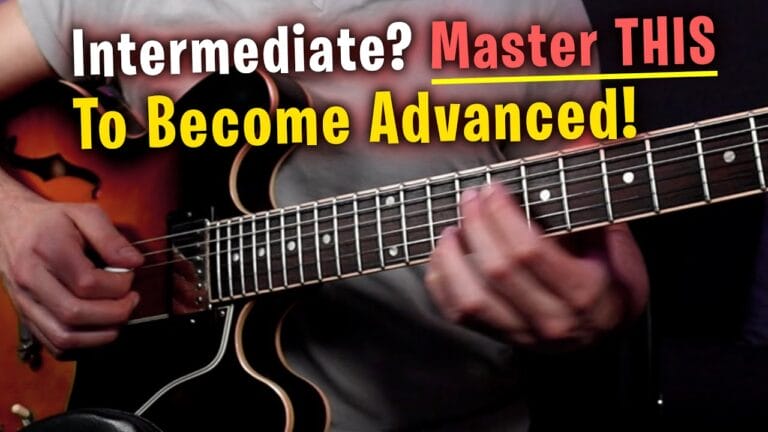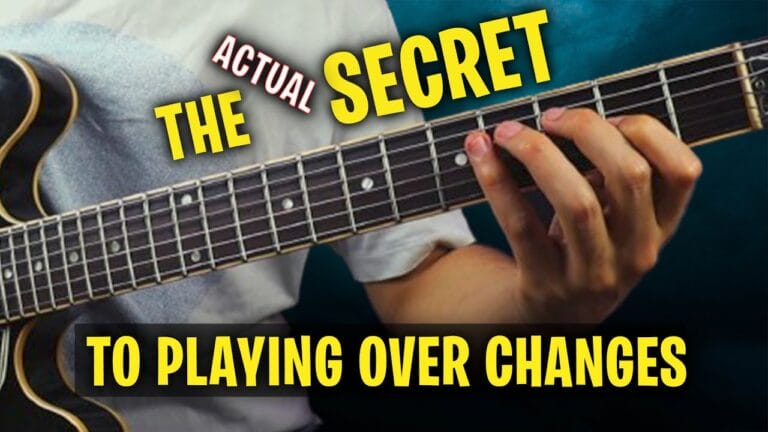Your BEBOP Lines sound like scales? Do This…
[Music]
In this lesson you’re gonna learn the most essential tools to create jazz bebop lines. I’m gonna show you my favorite tools that you can start implementing to any scale you learn. So let’s begin.
Diatonic Thirds
So here’s the C major scale right, starting with the second finger on the A string. Now I’m gonna stack those thirds over here. So I’m gonna get C, I’m gonna skip D, gonna get E, skip F, gonna get G, skip A, gonna get B, skip C, gonna get D, then I get F and A.
Now if you think about this in harmonic numbers we basically have a root, third, fifth, major seven, nine, eleven, thirteen.
[Music]
So what we’re going to do right now is we’re going to come up in those stacking thirds, and to make some contrast in our lines, we’re going to come back in the scalier movement. So we have seconds coming back up in thirds, back in seconds.
[Music]
Let’s do this on the next scale degree: D minor, stacking thirds.
[Music]
Back in seconds.
[Music]
Next scale degree: E minor, stacking thirds.
[Music]
Back in seconds.
[Music]
F major.
[Music]
Back in seconds.
G7, stacking thirds.
[Music]
Back in seconds.
A minor seven, stacking thirds.
[Music]
Back in seconds.
B minor seven flat five, stacking thirds.
[Music]
Back in seconds.
Exercise
Cool, still sounds like an exercise right? Now we’re going to add some written variety, specifically 16th notes, triplets, that kind of stuff. We’re talking about swing here, right? So just before playing that C, I’m going to approach it a half step below, and then I’m going to utilize some triplets: one, two, three.
[Music]
Going to root. So this is like a cage surrounding that note; it’s an enclosure. You can see that there is one chromatic note in there: the C sharp does not belong to the scale, but it does utilize the purpose of me wanting to land on a strong beat. So now I can play my phrase: one, two, three.
[Music]
Nice. Let’s do that to the other scale degrees: D minor seven, half step below approach, stacking thirds, coming back in the scale, creating an enclosure to land on a strong beat on the root: one, two, three.
[Music]
Cool, see this is the enclosure.
[Music]
Okay, third degree: one, two, three, half step, stacking thirds, then coming back into scale, enclosure: right, one, two, three.
[Music]
Yes, this F sharp is not part of the C major scale, but I’m utilizing it as an enclosure to my roots: F major seven: one, two, three.
[Music]
G7: one, two, three.
[Music]
Okay, we’re always approaching a half step below to start our phrase: one, two, three.
[Music]
So over here we have G sharp going into A, right? Then we’re going to have B minor 7 flat 5, so also approaching a half step below, stacking thirds.
[Music]
So that’s an interesting point over here because I use C sharp; that’s pretty spicy, right?
[Music]
So if you take the set of tools I presented in this video and you create lines like this:
[Music]
Try to now move them up a diatonic level, right? So my next diatonic degree would be D minor. So how would they do that? Well, what happened?
[Music]
Right, it’s not exactly the same, but it’s the same tools applied on the C major seven I played.
[Music]
These kind of movements, using the tools I explained, and on my D minor 7, my next scale degree, I’m going to utilize the same kind of concepts: enclosures, stacking thirds, approach notes.
[Music]
Stacking thirds, right? Enclosure into the root, scale your enclosure into the five, scale your movement.
[Music]
Approach notes into the third. So you see all of these come into play. Now when you practice them very technically at first, it doesn’t really sound or feel natural, right? Like anything, because jazz is kind of like a language—I mean, it is the language—and what will happen is once you start practicing these, you’re just getting your muscle memory to start working. Then you’re gonna listen to some recordings, some amazing jazz albums and some solos, and you’re gonna understand that language a little bit more from time to time. This is just washing your brain with all of those sounds and kind of going like, “Oh, that’s so cool. I wonder what he did there. Let me pause the recording, listen again. Oh, well, that I think that’s the enclosure Daniel talked about in the video, right? Oh, here’s that chromatic movement he talked about. Interesting.” So, you know, just look for those stuff in the music you listen to, especially bebop jazz, because that is where that comes into play the most.
Galactic Modern Guitar
This lesson is actually based on my guitar series Galactic Modern Guitar. In those 15 modules, over 96 videos, I go over everything that makes your harmonic melodic guitar knowledge fantastic and solid. The heart of the course is all based on step-by-step foundation guidance with PDFs, notation, videos, and easy-to-follow instructions. Definitely a course I wish I had when first getting into these stuff. I put months and months of hard work into it, and I think it’s a great resource for anyone who is looking for really strong harmonic melodic foundations and solid fretboard knowledge. You can check it out in the link in the description of this video.
So that’s it for today. Please make sure to subscribe and hit the bell. I’m gonna upload a video every week, sometimes even two times a week, and I’m really looking forward to hearing from you in the comments. What are some challenges that you have been struggling with when it comes to line construction and understanding jazz vocabulary so I can create better videos specifically for you?
Now if you enjoyed this lesson, click one of those videos and check out what’s going on on this channel. And I’m really looking forward to hearing from you. So stay in touch. I’ll see you in the next video. Bye.
Do you sometimes feel your Bebop lines sound like scales?
Having knowledge and knowing the theory is one thing,
but knowing how to use it is another.
In our case today – jazz Bebop improvisation. I hear so many aspiring guitarsists telling me their Bebop lines sound like scales..
So, in this video lesson I’ll show you a super effective bebop workout that will transform the way your Bebop lines sound..
Furthermore, you’ll see how I’ve been putting that control into actual musical phrases.
Study and practice these examples until they become habits and apply them into your own playing, tunes, and jams.
You’ll be improvising like a pro!
I have included the full Transcription of this lesson in my Galactic Modern Guitar Series so if you are really serious about your playing you must check it out.









